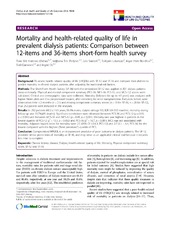| dc.contributor.author | Østhus, Tone Brit Hortemo | |
| dc.contributor.author | Preljevic, Valjbona | |
| dc.contributor.author | Sandvik, Leiv | |
| dc.contributor.author | Leivestad, Torbjørn | |
| dc.contributor.author | Nordhus, Inger Hilde | |
| dc.contributor.author | Dammen, Toril | |
| dc.contributor.author | Os, Ingrid | |
| dc.date.accessioned | 2014-07-04T09:10:02Z | |
| dc.date.available | 2014-07-04T09:10:02Z | |
| dc.date.issued | 2012-05-06 | eng |
| dc.identifier.issn | 1477-7525 | |
| dc.identifier.uri | https://hdl.handle.net/1956/8054 | |
| dc.description.abstract | Background: To assess health- related quality of life (HRQOL) with SF-12 and SF-36 and compare their abilities to predict mortality in chronic dialysis patients, after adjusting for traditional risk factors. Methods: The Short-Form Health Survey (SF-36) with the embedded SF-12 was applied in 301 dialysis patients cross-sectionally. Physical and mental component summary (PCS-36, MCS-36, PCS-12, and MCS-12) scores were calculated. Clinical and demographic data were collected. Mortality (followed for up to 4.5 years) was analyzed with Kaplan Meier plots and Cox proportional hazards, after censoring for renal transplantation. Exclusion factors were observation time < 2 months (n = 21) and missing component summary scores (n = 10 for SF-36; n= 28 for SF-12), thus 252 patient were included in the analyses. Results: In 252 patients (60.2 ± 15.5 years, 65.9% males, dialysis vintage 9.0, IQR 5.0-23.0 months), mortality during follow-up was 33.7%.(85 deaths). Significant correlations were observed between PCS-36 and PCS-12 (ρ = 0.93, p < 0.001) and between MCS-36 and MCS-12 (ρ = 0.95, p < 0.001). Mortality rate was highest in patients in the lowest quartile of PCS-12 (χ2 = 15.3, p = 0.002) and PCS-36 (χ2 = 16.7, p = 0.001). MCS was not associated with mortality. Adjusted hazard ratios for mortality were 2.5 (95% CI 1.0-6.3, PCS-12) and 2.7 (1.1–6.4, PCS-36) for the lowest compared with the highest (“best perceived”) quartile of PCS. Conclusion: Compromised HRQOL is an independent predictor of poor outcome in dialysis patients. The SF-12 provided similar predictions of mortality as SF-36, and may serve as an applicable clinical tool because it requires less time to complete. | en_US |
| dc.language.iso | eng | eng |
| dc.publisher | BioMed Central | eng |
| dc.rights | Attribution CC BY | eng |
| dc.rights.uri | http://creativecommons.org/licenses/by/2.0 | eng |
| dc.subject | Chronic kidney disease | eng |
| dc.subject | Dialysis | eng |
| dc.subject | Health-related quality of life | eng |
| dc.subject | Mortality | eng |
| dc.subject | Physical component summary score | eng |
| dc.subject | SF-12 and SF-36 | eng |
| dc.title | Mortality and health-related quality of life in prevalent dialysis patients: Comparison between 12-items and 36-items short-form health survey | eng |
| dc.type | Peer reviewed | |
| dc.type | Journal article | |
| dc.date.updated | 2013-08-23T09:19:56Z | |
| dc.description.version | publishedVersion | |
| dc.description.version | Peer Reviewed | |
| dc.rights.holder | Copyright 2012 Østhus et al.; licensee BioMed Central Ltd. | |
| dc.rights.holder | Tone Brit Østhus et al.; licensee BioMed Central Ltd. | eng |
| dc.source.articlenumber | 46 | |
| dc.identifier.doi | https://doi.org/10.1186/1477-7525-10-46 | |
| dc.identifier.cristin | 964595 | |
| dc.source.journal | Health and Quality of Life Outcomes | |
| dc.source.40 | 10 | |

